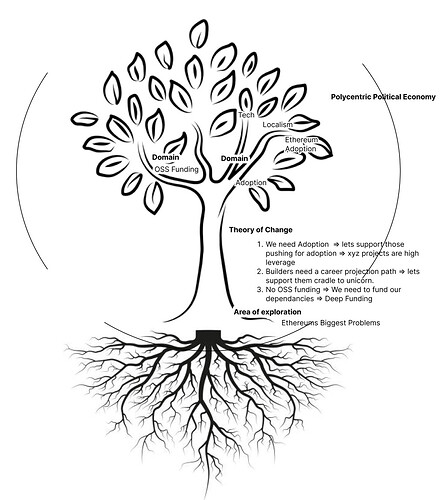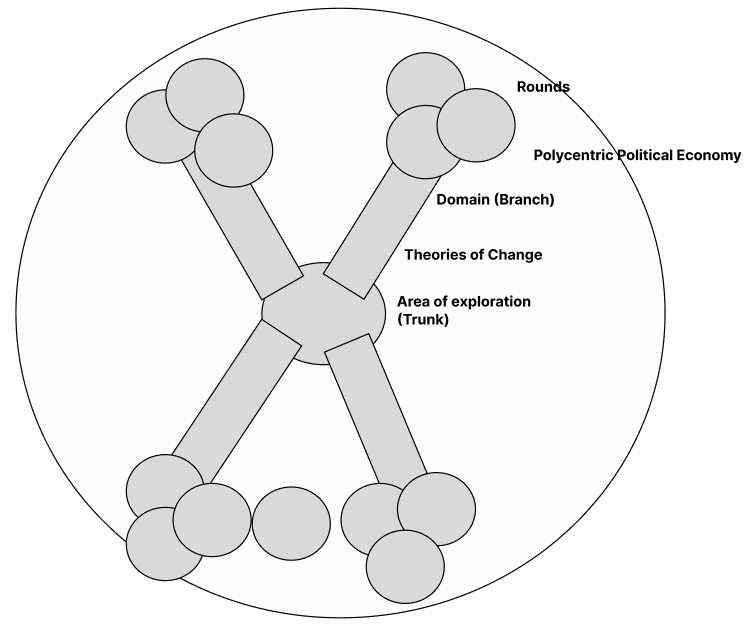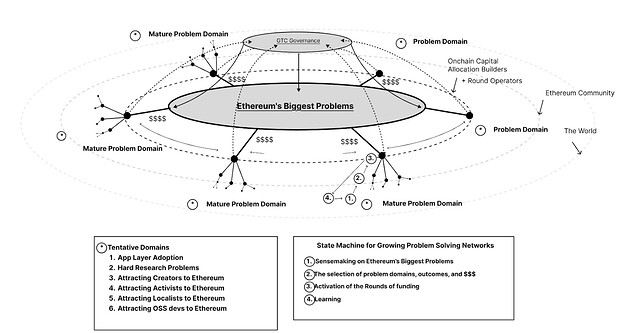TLDR in 1 sentence
Gitcoin Grants 3.0 can fund what truly matters by grounding decisions in truth. We can use an epistemological tree to build a shared understanding of truth.
TLDR in 5 bullet points
- GG24 must be rooted in truth — to fund what matters, not just what’s trending. That means understanding Ethereum’s real problems and where Gitcoin can uniquely help.
- Epistomology is the study of how we know what we know — it’s about understanding the sources, limits, and validity of knowledge. In simple terms, it asks: How do we decide what’s true or worth believing?
- Building an epistemological tree maps this from ground truth to core issues to how we learn about them to actionable funding.
- Ethereum is polycentric — a decentralized system of many actors where coordination comes from alignment, not control, and not governance. GG24 must work within this pluralism by enabling modular, legitimacy-driven sensemaking and funding.
- An epistemological tree can help us orient GG24’s process — sensemaking, domain selection, campaign execution, and learning — turning Gitcoin into an evolving engine for high-leverage impact.
 The Epistemological Tree of GG24
The Epistemological Tree of GG24
As Gitcoin evolves toward its 3.0 vision, we’re not just launching new funding rounds — we’re rebuilding the way we reason about impact. The process of designing GG24 isn’t a list of tactics; it’s a framework grounded in deeper questions: What matters? What’s solvable? What’s fundable? Who decides?
These questions need to be grounded in truth. Epistemology is the study of how we know what we know — it’s about understanding the sources, limits, and validity of knowledge. In simple terms, it asks: How do we decide what’s true or worth believing?
How do we build a solid epistemology of where to deploy resources in GG24? Especially one that doesnt hide all of the beautiful complexity + details inherent in a political economy like Ethereum?
To visualize that complexity, I am exploring a model called the Epistemological Tree. It helps us reason from first principles, build shared understanding, and ultimately fund what matters most in the Ethereum ecosystem.
 What Is an Epistemological Tree?
What Is an Epistemological Tree?
An epistemological tree is a visual or conceptual structure used to represent knowledge hierarchically, illustrating how beliefs, ideas, or truths logically branch out from fundamental assumptions or axioms.
An epistemological tree is a conceptual tool that maps how we generate knowledge and make decisions.
- The roots represent axioms — foundational beliefs and assumptions about the world.
- The trunk is our shared frame of exploration — what we agree is worth understanding or solving.
- The branches are theories, domains, or directions that emerge from that shared exploration.
- The leaves are specific outcomes — rounds, grants, tools, mechanisms, or learnings.
In short: it’s a map of how ideas grow from assumptions into action.
 What Are the Roots of Gitcoin’s Epistemological Tree?
What Are the Roots of Gitcoin’s Epistemological Tree?
The roots of Gitcoin Grants are the biggest unresolved problems in Ethereum. These are not just technical bugs or UX issues — they’re existential questions:
- Why don’t more developers stay in Ethereum long-term?
- Why is adoption still bottlenecked?
- How do we fund public goods sustainably without extractive capture?
- What types of problems are best solved by networks vs. hierarchies?
Our roots are built on the belief that the Ethereum ecosystem must solve these problems to mature — and that Gitcoin’s job is to help coordinate the capital and the talent to do so.
𑗕 What is the Ontology of Gitcoin’s Epistemological Tree?
Ontology is the study of what exists — the categories, entities, and relationships that make up a system or reality. It answers the question: What are the things that matter, and how are they related?
The ontology of Ethereum consists of a layered, decentralized system made up of accounts, contracts, transactions, state, and protocol rules. At a higher level, it includes actors (like DAOs, developers, L2s, and users), resources (ETH, tokens, attention, code), and coordination mechanisms (consensus, governance, funding). These elements interact on a shared, permissionless infrastructure, where no single entity controls the system — instead, value and meaning emerge from the interactions between many autonomous yet interoperable parts.
This ontology forms the fertile soil through which the epistomological tree of GG grows. This fertile soil, or context, is inseparable from the nature of Ethereum itself — a polycentric political economy. In a polycentric system, power doesn’t flow from a single authority; instead, it emerges from many interdependent centers of decision-making — L1 protocol devs, L2s, DAOs, dapps, researchers, community nodes, and funders. Each acts with partial autonomy, yet shares a common substrate: Ethereum.
This means coordination must happen through alignment, legitimacy, and shared mental models, not coercion. The epistemological tree reflects this reality: it’s not just a decision framework for Gitcoin, but a cognitive map for making sense of a decentralized, pluralistic, evolving ecosystem. It helps different actors orient to shared problems, generate actionable knowledge, and coordinate capital — even when no one is in charges
 Visualizing The Epistomological Tree (From the Side)
Visualizing The Epistomological Tree (From the Side)
In the first visual metaphor, Gitcoin’s grants ecosystem is shown as a literal tree:
- Roots: Ethereum’s biggest problems, and all of the dirty complexities, details, and assumptions that we must know about to reason about them.
- Trunk: Areas of exploration
- Branches: Domains of action like OSS funding, Ethereum localism, and Ethereum adoption
- Leaves: Rounds that fund what mattress. Projects with real-world initiatives and outcomes.
Each branch stems from a theory of change, such as:
- “We need OSS developers to thrive, so we’ll build a career path and fund critical dependencies for them.”
- “Ethereum needs adoption, so we’ll support app-layer experiments and local onboarding with proven results.”
The above examples are simplistic and reductive; True theories of change have a much stronger epistemological grounding.
This image reflects the organic, layered nature of Gitcoin’s evolution: rooted in values, growing through structured domains, and flowering into visible impact.
 Visualizing The Epistomological Tree (Top Down)
Visualizing The Epistomological Tree (Top Down)
The second image reinterprets the epistemological tree top down.
- The trunk is an area of exploration — like “Ethereum’s biggest problems.”
- Each branch represents a domain of focus.
- Each node at the edges represents a funding round or project within that domain.
This shows how Gitcoin 3.0 is not just a linear pipeline — it’s a modular network of ideas, actors, and mechanisms built around a polycentric economy - and proposed by a network of individuals. Each part of the network can evolve, fork, or interconnect. It’s built for polycentrism — where multiple funding methods and actors can co-exist and compete.
 Visualizing The Epistomological Tree (3d)
Visualizing The Epistomological Tree (3d)
OK, HODL my beer.
This third representation of our epistemological tree zooms out even further — portraying Gitcoin as a emergent state machine for growing problem-solving networks.
- Center: The area of exploration, Ethereum’s biggest problems (gravitational core)
- Orbits: Problem domains like app adoption, hard research, localism, OSS dev support
- Outer Shells: Governance and capital allocation activation loops
- Process:
- Sensemaking
- Domain selection
- Campaign activation
- Retrospective learning
This metaphor highlights the strategic choreography of Gitcoin Grants 3.0. It’s not just a bunch of rounds — it’s an ecosystem-wide emergent coordination network that cycles through learning loops to improve over time. And grows like a slime mold.
 Conclusion: Why This Matters
Conclusion: Why This Matters
The epistemological tree gives Gitcoin a compass — a way to align funding, relevance, and legitimacy. In a world full of noise, short attention spans, and shallow grants programs, Gitcoin 3.0 is doubling down on reasoned capital allocation.
We’re not just asking: “What’s hot right now?”. We’re not just trying to QF every problem in the world. We’re asking:
- What is true about the world?
- What can Ethereum uniquely solve?
- What should we fund, and why?
- How should we allocate funding to it?
By grounding our grants ecosystem in this layered epistemology, Gitcoin is planting the seeds for more thoughtful, credible, and scalable coordination — for GG24 and beyond.


